Abstract
The effects of intravenously administered endotoxin on the hepatic and systemic circulation as well as on the coagulation system were evaluated in normal rats (n = 26), in rats with experimental portal hypertension (n = 15), and in rats with portacaval anastomosis (n = 22). Endotoxin (1-5 mg/kg) in the normal rat leads to a prompt increase of transaminase activity and to a hyperdynamic circulation with a consequent increase in the total hepatic blood flow. In a later phase (6 h postoperatively) the hepatic artery dilated with a consequent hepatic arterial hyperperfusion. The coagulation system was affected with signs of consumption coagulopathy. In the rats with portal hypertension and portacaval collaterals as well as in those with portacaval anastomosis, the endotoxin injection resulted in acute liver necrosis within 12 to 15 hours. The hepatic artery became overdilated with a cardiac output fraction of 25% (normal 5-5%). Blood extravasates and thrombi, rich in fibrin, were detected in the liver. It is suggested that this exaggeration of the endotoxin effect was due to an impaired clearance function of the reticuloendothelial system, probably as consequence of portacaval collateral circulation. It is concluded that endotoxins (1) damage the liver even in a normal organism; (2) are potent to induce acute liver necrosis, if the reticuloendothelial system is altered; (3) have to be taken into consideration as contribution to the pathogenesis of acute as well as chronic liver diseases.
Full text
PDF

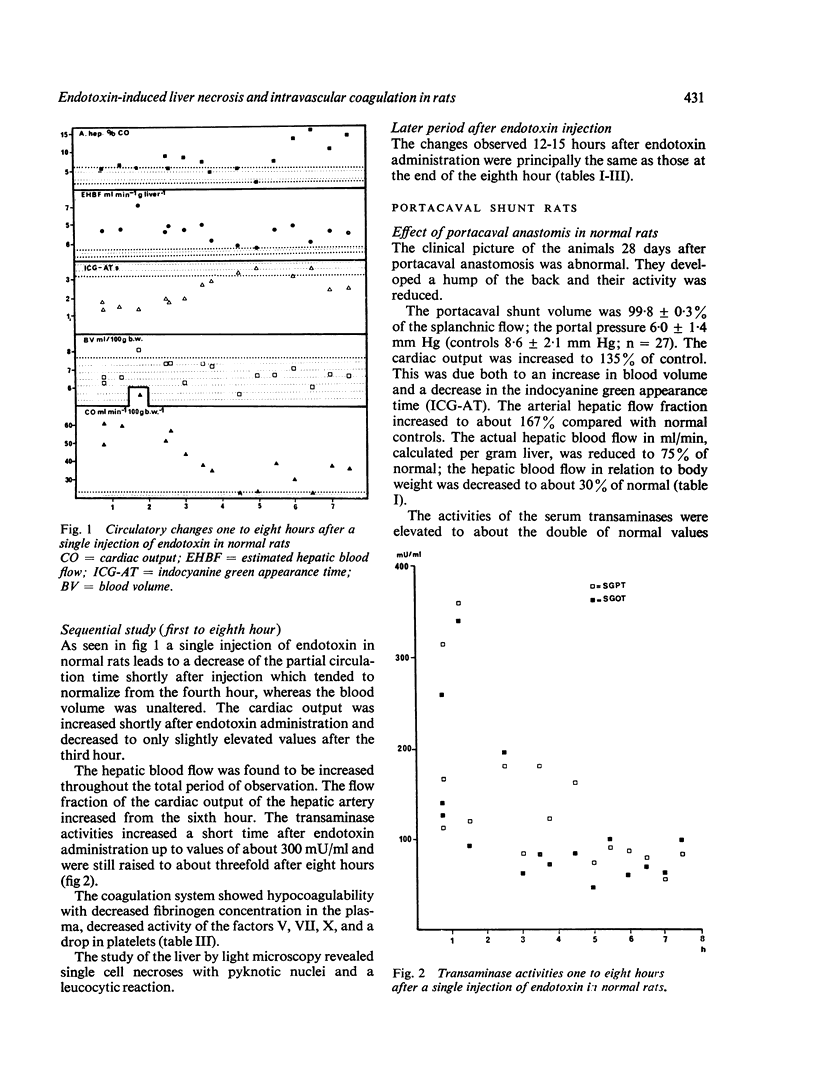

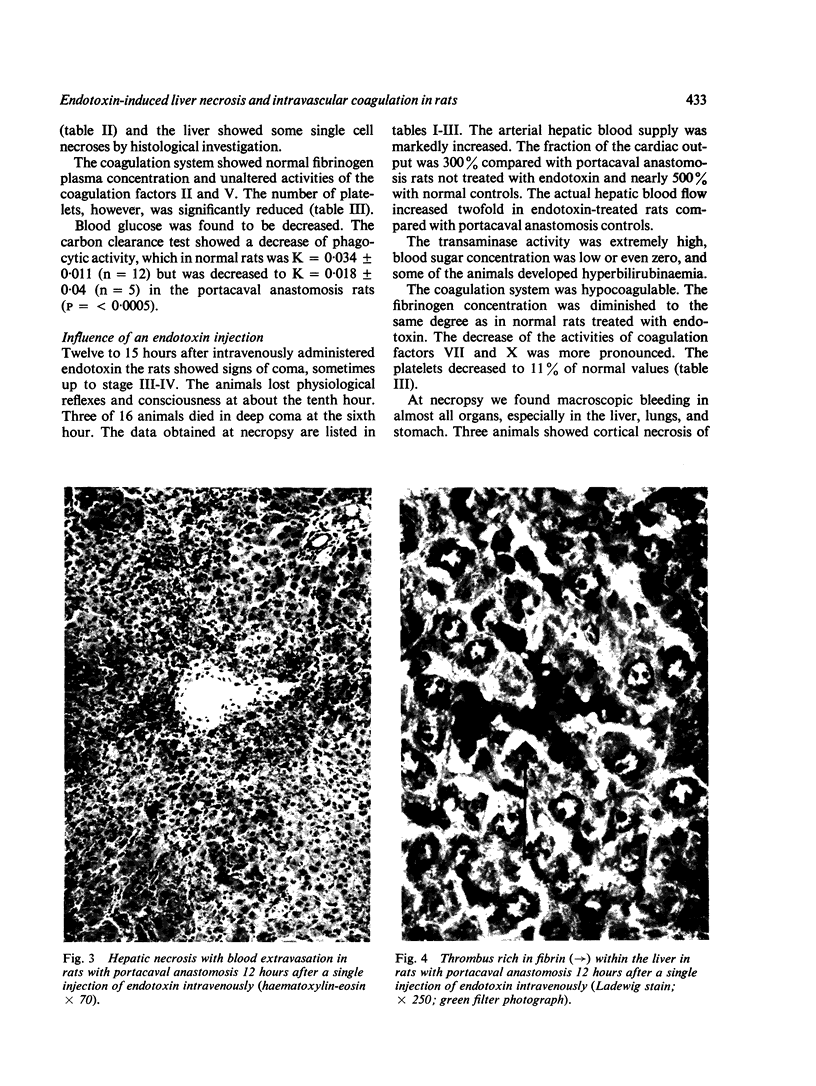
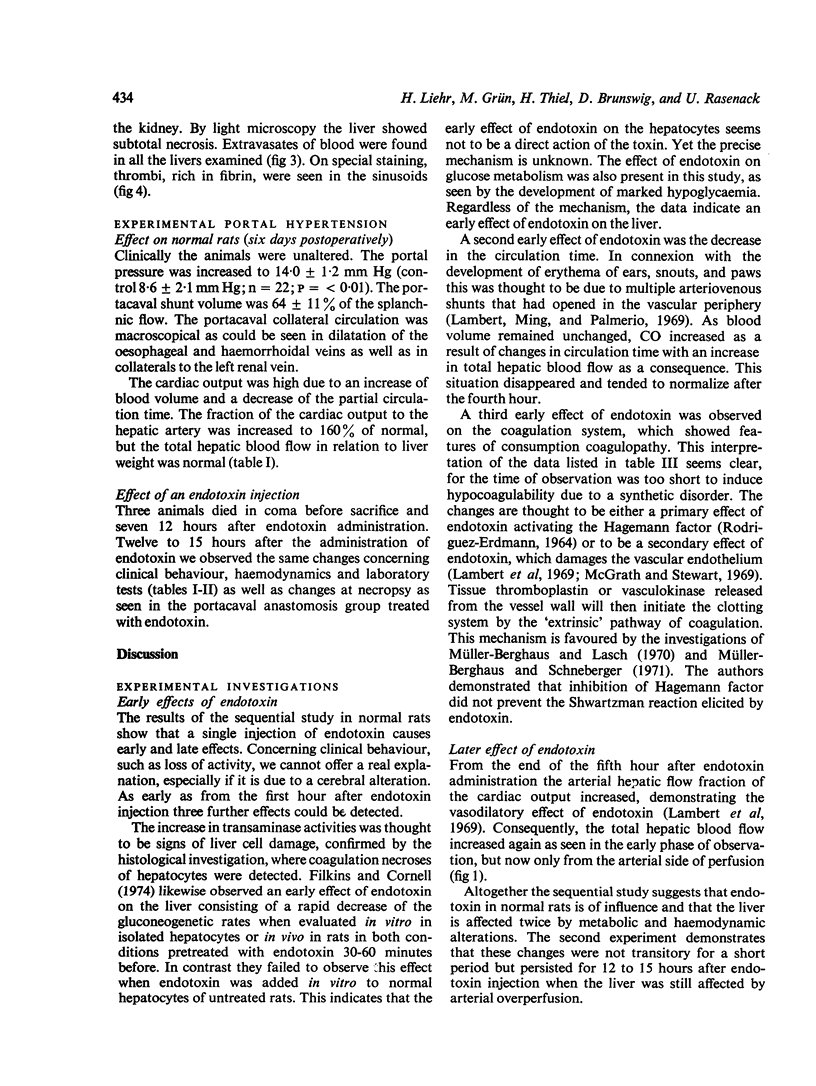
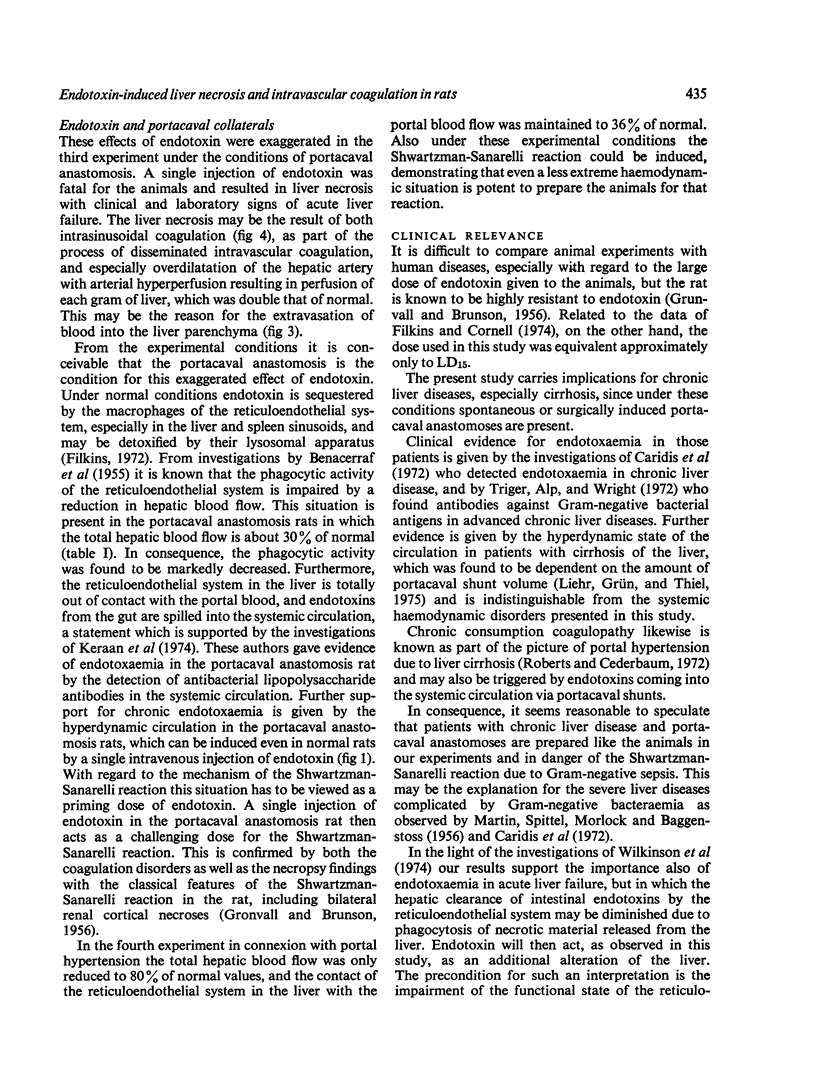
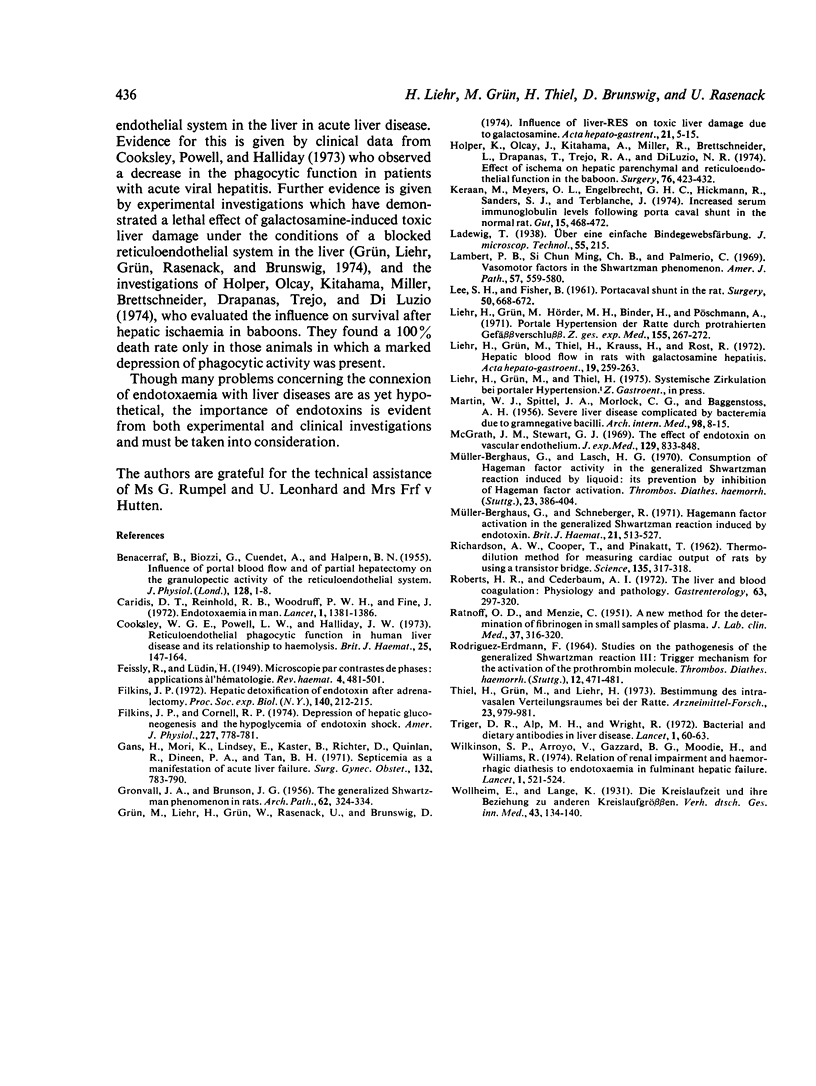
Images in this article
Selected References
These references are in PubMed. This may not be the complete list of references from this article.
- BENACERRAF B., BIOZZI G., CUENDET A., HALPERN B. N. Influence of portal blood flow and of partial hepatectomy on the granulopectic activity of the reticulo-endothelial system. J Physiol. 1955 Apr 28;128(1):1–8. doi: 10.1113/jphysiol.1955.sp005288. [DOI] [PMC free article] [PubMed] [Google Scholar]
- BRUNSON J. G., GRONVALL J. A. The generalized Shwartzman phenomenon in rats. AMA Arch Pathol. 1956 Oct;62(4):324–334. [PubMed] [Google Scholar]
- Caridis D. T., Reinhold R. B., Woodruff P. W., Fine J. Endotoxaemia in man. Lancet. 1972 Jun 24;1(7765):1381–1385. doi: 10.1016/s0140-6736(72)91108-7. [DOI] [PubMed] [Google Scholar]
- Cooksley W. G., Powell L. W., Halliday J. W. Reticuloendothelial phagocytic function in human liver disease and its relationship to haemolysis. Br J Haematol. 1973 Aug;25(2):147–164. doi: 10.1111/j.1365-2141.1973.tb01725.x. [DOI] [PubMed] [Google Scholar]
- FEISSLY R., LUDIN H. Microscopie par contrastes de phases; applications à l'hématologie. Rev Hematol. 1949;4(3):481–501. [PubMed] [Google Scholar]
- Filkins J. P., Cornell R. P. Depression of hepatic gluconeogenesis and the hypoglycemia of endotoxin shock. Am J Physiol. 1974 Oct;227(4):778–781. doi: 10.1152/ajplegacy.1974.227.4.778. [DOI] [PubMed] [Google Scholar]
- Filkins J. P. Hepatic detoxification of endotoxin after adrenalectomy. Proc Soc Exp Biol Med. 1972 May;140(1):212–215. doi: 10.3181/00379727-140-36428. [DOI] [PubMed] [Google Scholar]
- Gans H., Mori K., Lindsey E., Kaster B., Richter D., Quinlan R., Dineen P. A., Tan B. H. Septicemia as a manifestation of acute liver failure. Surg Gynecol Obstet. 1971 May;132(5):783–790. [PubMed] [Google Scholar]
- Grün M., Liehr H., Grün W., Rasenack U., Brunswig D. Influence of liver-RES on toxic liver damage due to galactosamine. Acta Hepatogastroenterol (Stuttg) 1974 Feb;21(1):5–15. [PubMed] [Google Scholar]
- Holper K., Olcay I., Kitahama A., Miller R. H., Brettschneider L., Drapanas T., Trejo R. A., Di Luzio N. R. Effect of ischemia on hepatic parenchymal and reticuloendothelial function in the baboon. Surgery. 1974 Sep;76(3):423–432. [PubMed] [Google Scholar]
- Keraan M., Meyers O. L., Engelbrecht G. H., Hickman R., Saunders S. J., Terblanche J. Increased serum immunoglobulin levels following portacaval shunt in the normal rat. Gut. 1974 Jun;15(6):468–472. doi: 10.1136/gut.15.6.468. [DOI] [PMC free article] [PubMed] [Google Scholar]
- LEE S. H., FISHER B. Portacaval shunt in the rat. Surgery. 1961 Oct;50:668–672. [PubMed] [Google Scholar]
- Lambert P. B., Ming S. C., Palmerio C. Vasomotor factors in the Shwartzman phenomenon. Am J Pathol. 1969 Dec;57(3):559–580. [PMC free article] [PubMed] [Google Scholar]
- Liehr H., Grün M., Thiel H., Krauss H., Rost R. Hepatic blood flow in rats with galactosamine hepatitis. Acta Hepatogastroenterol (Stuttg) 1972 Jul-Aug;19(4):259–263. [PubMed] [Google Scholar]
- MARTIN W. J., SPITTEL J. A., MORLOCK C. G., BAGGENSTOSS A. H. Severe liver disease complicated by bacteremia due to gramnegative bacilli. AMA Arch Intern Med. 1956 Jul;98(1):8–15. doi: 10.1001/archinte.1956.00250250014002. [DOI] [PubMed] [Google Scholar]
- McGrath J. M., Stewart G. J. The effects of endotoxin on vascular endothelium. J Exp Med. 1969 May 1;129(5):833–848. doi: 10.1084/jem.129.5.833. [DOI] [PMC free article] [PubMed] [Google Scholar]
- Müller-Berghaus G., Lasch H. G. Consumption of Hageman factor activity in the generalized Shwartzman reaction induced by liquoid. Its prevention by inhibition of Hageman factor activation. Thromb Diath Haemorrh. 1970 May 31;23(2):386–404. [PubMed] [Google Scholar]
- Müller-Berghaus G., Schneberger R. Hageman factor activation in the generalized Shwartzman reaction induced by endotoxin. Br J Haematol. 1971 Nov;21(5):513–527. doi: 10.1111/j.1365-2141.1971.tb02713.x. [DOI] [PubMed] [Google Scholar]
- RATNOFF O. D., MENZIE C. A new method for the determination of fibrinogen in small samples of plasma. J Lab Clin Med. 1951 Feb;37(2):316–320. [PubMed] [Google Scholar]
- RICHARDSON A. W., COOPER T., PINAKATT T. Thermodilution method for measuring cardiac output of rats by using a transistor bridge. Science. 1962 Jan 26;135(3500):317–318. doi: 10.1126/science.135.3500.317. [DOI] [PubMed] [Google Scholar]
- Roberts H. R., Cederbaum A. I. The liver and blood coagulation: physiology and pathology. Gastroenterology. 1972 Aug;63(2):297–320. [PubMed] [Google Scholar]
- Thiel H., Grün M., Liehr H. Bestimmung des intravasalen Verteilungsraumes bei der Ratte. Arzneimittelforschung. 1973 Jul;23(7):979–981. [PubMed] [Google Scholar]
- Triger D. R., Alp M. H., Wright R. Bacterial and dietary antibodies in liver disease. Lancet. 1972 Jan 8;1(7741):60–63. doi: 10.1016/s0140-6736(72)90061-x. [DOI] [PubMed] [Google Scholar]
- Wilkinson S. P., Arroyo V., Gazzard B. G., Moodie H., Williams R. Relation of renal impairment and haemorrhagic diathesis to endotoxaemia in fulminant hepatic failure. Lancet. 1974 Mar 30;1(7857):521–524. doi: 10.1016/s0140-6736(74)92711-1. [DOI] [PubMed] [Google Scholar]




